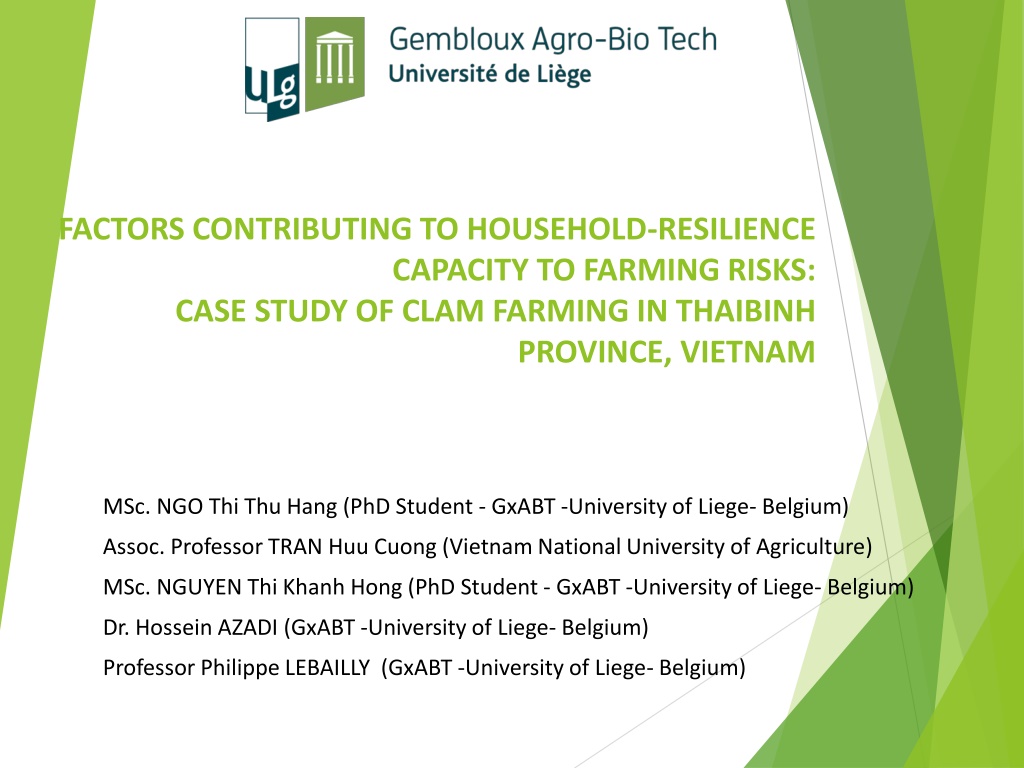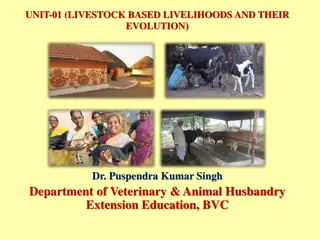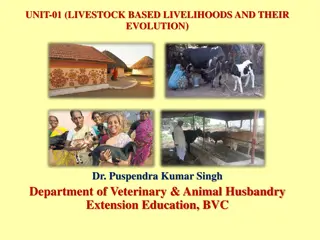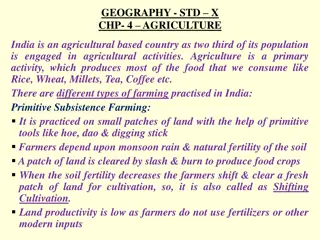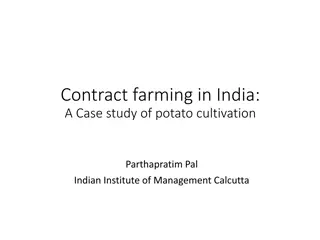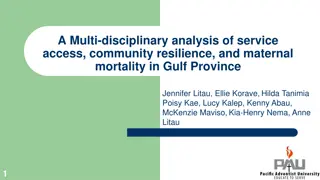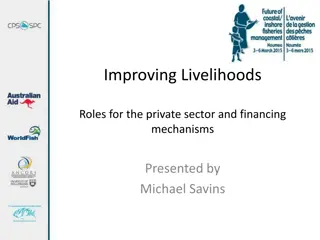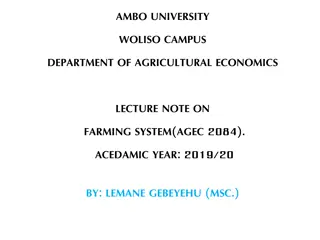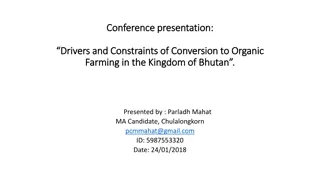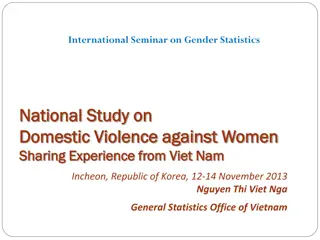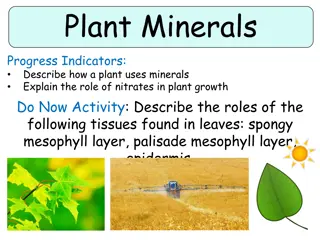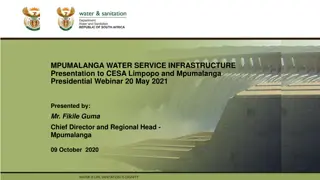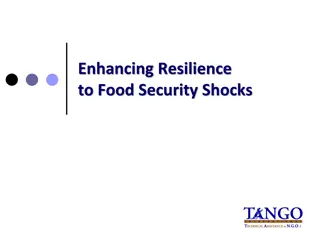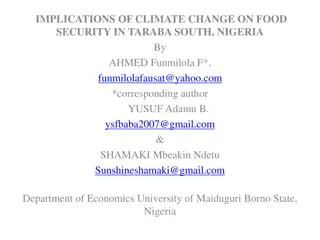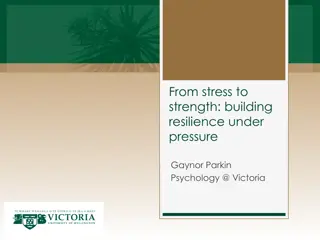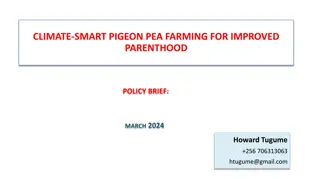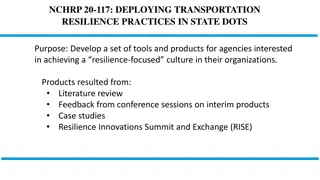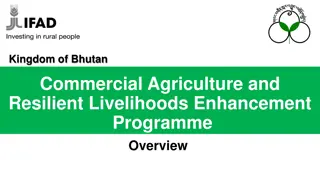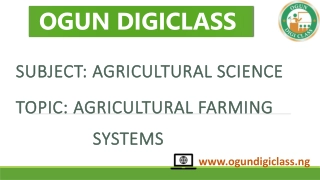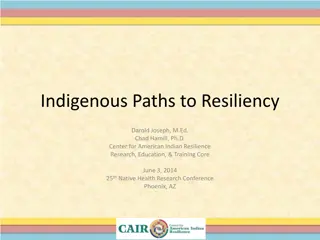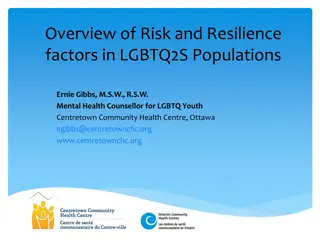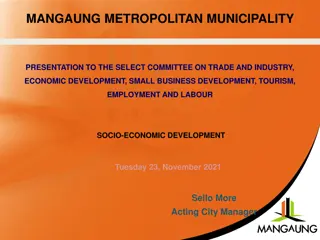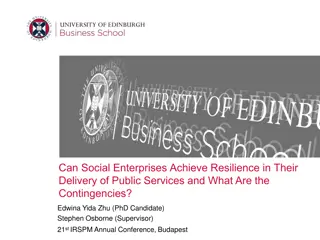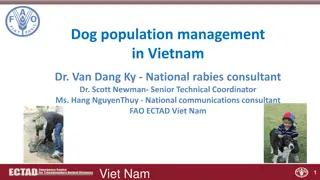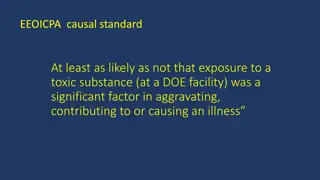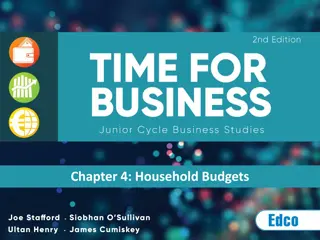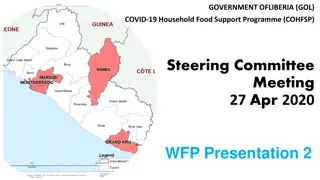Factors Contributing to Household Resilience in Clam Farming Risks: A Case Study in Thaibinh Province, Vietnam
Study explores factors contributing to household resilience in clam farming risks in Thaibinh Province, Vietnam. Despite challenges like pollution and climate change, clam farmers exhibit strong resilience. Research methods include a Subjective Well-Being approach to gauge farmers' perception on their resilience.
Download Presentation

Please find below an Image/Link to download the presentation.
The content on the website is provided AS IS for your information and personal use only. It may not be sold, licensed, or shared on other websites without obtaining consent from the author. Download presentation by click this link. If you encounter any issues during the download, it is possible that the publisher has removed the file from their server.
E N D
Presentation Transcript
FACTORS CONTRIBUTING TO HOUSEHOLD-RESILIENCE CAPACITY TO FARMING RISKS: CASE STUDY OF CLAM FARMING IN THAIBINH PROVINCE, VIETNAM MSc. NGO Thi Thu Hang (PhD Student - GxABT -University of Liege- Belgium) Assoc. Professor TRAN Huu Cuong (Vietnam National University of Agriculture) MSc. NGUYEN Thi Khanh Hong (PhD Student - GxABT -University of Liege- Belgium) Dr. Hossein AZADI (GxABT -University of Liege- Belgium) Professor Philippe LEBAILLY (GxABT -University of Liege- Belgium)
CONTEXT (1) Vietnam is a developing country located in the southeast Asia Having over 3,260 km of the coastal line and 112 estuaries Being the 6th country in the world in terms of the population density living in coastal areas The aquaculture avr. growth rate is estimated >17% since 2000 with an export value of $ 6,700 million in 2015 (VASEP, 2016). Ranked as the 18th country in 2015 with the vulnerability index of 50.87% (Garschagen, Hagenlocher et al. 2016).
CONTEXT (2) Coastal endowment is not only a good opportunity for farmer s clam production, but also embedded with risks. Clam farmers have been experiencing increased difficulties in production: + Polluted water discharged from inland agricultural and industrial activities + Increased negative impacts of climate changes, especially in terms of irregular temperature patterns.
Figure 1. Clam production area and yield (2006-2014) ha ton/ha 4,000 25.00 3,500 20.00 3,000 2,500 15.00 2,000 10.00 1,500 1,000 5.00 500 Figure 2. Total gross revenue of clam production (2006-2014) - 0.00 Year Area (ha) Average yield (ton/ha) VND bil. 1000. VND/kg (Source: Thai Binh Statistical Office, 2015) 20.00 800 15.00 600 10.00 400 5.00 200 - 0 Year Clam market price (VND/kg) Total gross output(VND bil.) (Source: Thai Binh Statistical Office, 2015)
CLAM PRODUCTION IN THAI BINH (2006-2014) Despite the risk, farmers in Thai Binh still continue clam production, 2009-2014: 59% of the total provincial aquacultural outputs (MaiLien, 2014). The clam continuation reveals a kind of strong resilience capacity of some of farmers among all clam farmers in Thai Binh province.
RESEARCH QUESTIONS What are the main factors contributing to farmer s resilience to clam farming risks? RESEARCH METHODS Subjective Well-Being approach (SWB) : Eleven statements (Table 1 next slides) related to the identified factors were put into the questionnaire for household survey to explore the farmers perception regarding their own resilience.
RESEARCH METHODS Exploratory Factor Analysis (EFA): Using NVivo (QSR) to manage the qualitative data and elicit key themes; And SPSS for analysing the quantitative data and producing a descriptive statistical analysis. Cronbach s alpha coefficient was applied to define the reliability of each variable. EFA was then carried out to combine related variables into group of variables .
Table 1: Eleven statements to explore factors affecting the household resilience I am confident that I have my own capital or successfully borrow formal credits to restart new clam cycle. Statement 1: Statement 2: In my opinion, decreased clam market price is associated with opportunity for a new clam production cycle. Statement 3: In my opinion, clam farming should be continued because its risks are tolerable. Statement 4: In my opinion, risks in clam farming are lower than those in other aquaculture activities. Statement 5: I am confident that diversified income-generated activities help me easily to restart a new clam production cycle after disaster. Statement 6: I am confident that loss of clam farming has no serious impact on our daily basic needs.
Table 1: Eleven statements to explore factors affecting the household resilience (cont.) Statement 7: My household have received supports from governments to recover from loss. Statement 8: I have gained many practical experiences about clam farming after each failing season. Statement 9: I have applied new production tools/practices (invented by other farmers) which really help us to reduce clam farming risks. Statement 10: I am confident that changes in clam production techniques help our clam farming less affected by (natural and market) shocks than other households. Statement 11: In my opinion, new clam production cycle started after shock has higher productivity than previous one.
RESEARCH SITE Selected communes for the research Thai Binh province DATA COLLECTION Direct observation Key informants interviews Household survey : 157 households
RESULT AND DISCUSSION CLAM FARMERS RESILIENCE TO RISKS 85% of the survey HHs underwent at least one loss cycle during the clam farming period 87% of households suffered from clam loss decided to start a new cycle, but the length of time needed were not the same (Figure 3) Despite their efforts, only 40% of these re-started group assessed that they had been recovered from the loss, after a different duration (Figure 4)
RESULT AND DISCUSSION Figure 3. Farmer s restart new clam production after disasters Percentage 35 30 25 20 15 10 5 Figure 4. Farmer s recover from clam loss 0 Duration (month) 1-5 6-10 11-15 15-20 >20 Percentages 100 80 60 40 20 - Duration (month) 12 18 24 30 42 48 60
INTERPRETATION OF FACTORS AFFECTING ON HHs RESILIENCE (Cont.) Table 2: Rotated Component Matrixa Statements Factor loading 1 2 .844 .812 .753 .662 .612 .772 .744 .687 4.289 1.310 43 13 10 3 Component 1: Farmer s ability in gaining experiences/ opportunities from failures S2 S11 S8 S10 S9 S6 S4 S3 S5 S1 Component 2: Farmer s perception about clam farming risks and its impacts Component 3: Farmer s confidence about financial capacity and incomes from diversification activities .877 .748 1.046 Eigenvalues % of variance Extraction Method: Principal Component Analysis. Rotation Method: Varimax with Kaiser Normalization.a a. Rotation converged in 4 iterations.
INTERPRETATION OF FACTORS AFFECTING ON HHs RESILIENCE (Cont.) Component 1: Farmer s ability in gaining experiences/opportunities from failures Although losses and their impacts counted (90%), most farmers took advantages from those shocks including practical experiences, opportunities or even chances for inventions/improvement production technics.
INTERPRETATION OF FACTORS AFFECTING ON HHs RESILIENCE (Cont.) Component 1: Farmer s ability in gaining experiences/opportunities from failures Box 1: Opinions of farmers who took opportunities to restart new clam cycles after shocks In 2013, renting cost for clam production plot and juvenile clam price were cheap. If farmers started new clam production when juvenile clam was cheap, a potential success could be 80%. If a loss happened (i.e., caused by storms), then it will be less serious because of low initial investment needed (interviewed on July 18, 2015, in Dong Minh commune). I restarted new clam production cycle after the down of clam market in 2013. The first reason- low input cost. The second reason - more food will be available for clams because many farmers stopped their clam production. The third reason - a better clam market could be expected (interviewed on July 21, 2015, in Thai Do commune).
INTERPRETATION OF FACTORS AFFECTING ON HHs RESILIENCE (Cont.) Component 1: Farmer s ability in gaining experiences/opportunities from failures (cont.) The pressure from risks also helped initiating some innovations associated with clam production at local level to improve clam production and harvesting practices . These inventions remarkably contribute to farmer s resilience capacity on continuing with clam production and recovering from losses caused by risks associated with clam production and marketing.
INTERPRETATION OF FACTORS AFFECTING ON HHs RESILIENCE Component 1: Farmer s ability in gaining experiences/opportunities from failures (cont.) Picture 1a: A clam catching machine helps reducing cost for clam harvest from 40-50 million VND/ha to only 5-6 million VND/ha Picture 1b: A clam cleaning machine helps to clean harvested clams before selling; reduced the risks of cheap price because of sands contained inside clam
INTERPRETATION OF FACTORS AFFECTING ON HHs RESILIENCE (Cont.) Component 2: Farmer s perception on clam farming risks and their impacts Figure 5: Percentage of households decided to restart after loss 98% 100% 92% 88% 86% 80% 75% 59% 50% Among 2 groups of answer for S3 Among 2 groups of answer for S4 Among 2 groups of answer for S6 Positive attitude Group Negative attitude Group
INTERPRETATION OF FACTORS AFFECTING ON HHs RESILIENCE (Cont.) Component 2: Farmer s perception on clam farming risks and their impacts (cont.) The idea of taking on risks is necessary to pursue opportunities for development and the risk of inaction may well be the worst option of all (WorldBank 2014); together with the positive thinking about the future of clam farming creates the confident of farmers to restart a new clam production cycle.
INTERPRETATION OF FACTORS AFFECTING ON HHs RESILIENCE Component 2: Farmer s perception on clam farming risks and their impacts (cont.) Box 2: Opinion of an experienced farmer: in clam farming, high risk is trade-off for its super profit Only clam can save clam farmers from loss. No local agricultural investment is more profitable than clam. One successful clam harvest like in period of 2009-2011 is sufficient for farmers to suffer from two to three harvest losses like in 2012 (interviewed on July 20, 2015, in Thai Do commune).
INTERPRETATION OF FACTORS AFFECTING ON HHs RESILIENCE Component 3: Farmer s confidence about financial capacity and incomes from diversification activities which can be used to invest in clam farming Data on the economic loss of 157 households within the sample size in period 2006-2014 reflected the serious economic impacts of loss to the clam farming. Clam households need time to compensate for the asset losses balance their own financial situation The risky characteristic of the clam production makes a high barrier for the clam farmers to access formal credit market, which then force them to come to the informal credit market. => Farmers seem to be reluctant to restart if they did not have confidence about their financial capacity, and also had lower probability to recover the loss
INTERPRETATION OF FACTORS AFFECTING ON HHs RESILIENCE (Cont.) Component 3: Farmer s confidence about financial capacity and incomes from diversification activities which can be used to invest in clam farming (cont.) Figure 6: Speed of restart and Percentage of recovery in relation with financial capacity Time need to start (months) Percemtage of recovery 30 60% 20 40% 10 20% - 0% Strongly Agree Agree Disagree Strongly Disagree 4 Groups of opinions about Statment 1 Time need to restart % of recovery
CONCLUSIONS Highly profitable but too risky investment can safely explain the clam production in Thai Binh province for the last two decades. Faced with these problems, a number of farmers stopped clam production, many are in trap of debts. However, most of them restarted raising clams after disasters with different time lags associated with their resilience capacity which is consisted into three major factors: (1) farmer s ability in learning and creativity from the failures; (2) farmer s perception on clam farming risks; and (3) farmer s financial capacity including their diversification of income- generated activities.
IMPLICATIONS Resilience capacity does not only require efforts from the clam farmers, but also external supports such as governments and other actors. It is suggested that following supports for farmers should be considered: (1) Support farmers to have the better accessing formal credit market; (2) Promoting farmer s livelihood diversification; and (3) Improving farmers capacity in learning to live with risks, gaining experiences and even converting risks to opportunities for themselves.
REFERENCES (1) Darnhofer, I. (2014). "Resilience and why it matters for farm management." European Review of Agricultural Economics 41(3): 461-484. Garschagen, M., et al. (2016). World Risk Report 2015. Hang, N. T. and N. T. D. Nga (2013). "Economic Performance of Clam Aquaculture In NamThinh Commune, TienHai District, ThaiBinh Province." Journal of Science and Development 11(1): 97- 106. Lebailly, P., et al. (2015). Capacity building and services to assist local farmers to improve aquaculture management in Vietnam. SAADC2015: The 5th International Conference on Sustainable Animal Agriculture for Developing Countries, Thailand, Rajamangala University of Technology Isan. MaiLien (2014). Clam production accounted for 59% of total aquaculture output of ThaiBinh Province, ThaiBinhTV. Marshall, N. A. and P. A. Marshall (2007). "Conceptualizing and operationalizing social resilience within commercial fisheries in northern Australia." Ecology and society 12(1): 1. Newhouse, D. (2005). "The persistence of income shocks: Evidence from rural Indonesia." Review of development Economics 9(3): 415-433. Nguyen, K. V., et al. (2013). "Measuring household resilience to floods: a case study in the Vietnamese Mekong River Delta." Ecology and society 18(3): 13. VASEP (2016). Report on Vietnam Seafood Export 2015, Vietnam Association of Seafood Exporters and Producers. Williams, B., et al. (2012). "Exploratory factor analysis: A five-step guide for novices." Australasian Journal of Paramedicine 8(3): 1.
Q & A Thank you for your attention!
